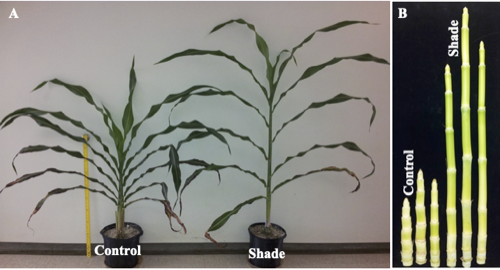Abstract
Stem internodes of bioenergy sorghum inbred R.07020 are longer at high plant density (shade) than at low plant density (control). Initially, the youngest newly‐formed subapical stem internodes of shade‐treated and control plants are comparable in length. However, full‐length internodes of shade‐treated plants are three times longer than the internodes of the control plants. To identify the early molecular events associated with internode elongation in response to shade, we analyzed the transcriptome of the newly‐formed internodes of shade‐treated and control plants sampled between 4 and 6 hr after the start of the light period (14 hr light/10 hr dark). Sorghum genes homologous to the Arabidopsis shade marker genes ATHB2 and PIL1 were not differentially expressed. The results indicate that shade signals promote internode elongation indirectly because sorghum internodes are not illuminated and grow while enclosed with leaf sheaths. Sorghum genes homologous to the Arabidopsis morning‐phased circadian clock genes LHY, RVE, and LNK were downregulated and evening‐phased genes such as TOC1, PRR5, and GI were upregulated in young internodes in response to shade. We hypothesize that a change in the function or patterns of expression of the circadian clock genes is the earliest molecular event associated with internode elongation in response to shade in bioenergy sorghum. Increased expression of CycD1, which promotes cell division, and decreased expression of cell wall‐loosening and MBF1‐like genes, which promote cell expansion, suggest that shade signals promote internode elongation in bioenergy sorghum in part through increasing cell number by delaying transition from cell division to cell expansion.
